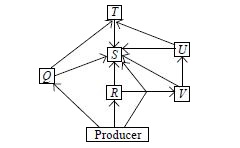Which of the following organisms are secondary consumers in the given food web?

V, U and S
V, T and S
V and T
Q and R
The correct Answer is:C
Step by step video, text & image solution for Which of the following organisms are secondary consumers in the given food web? by Biology experts to help you in doubts & scoring excellent marks in Class 10 exams.
Updated on:21/07/2023Topper's Solved these Questions
- NSO QUESTION PAPER 2018 SET BBOOK - SCIENCE OLYMPIAD FOUNDATION CHAPTER - NSO QUESTION PAPER 2018 SET BEXERCISE - ACHIEVERS SECTION
2 Videos
- NSO QUESTION PAPER 2018 SET ABOOK - SCIENCE OLYMPIAD FOUNDATION CHAPTER - NSO QUESTION PAPER 2018 SET AEXERCISE - Achievers Section
2 Videos
- NSO QUESTION PAPER 2019 SET ABOOK - SCIENCE OLYMPIAD FOUNDATION CHAPTER - NSO QUESTION PAPER 2019 SET AEXERCISE - ACHIEVERS SECTIONS
1 Videos
Similar Questions
Which of the following species is a primary consumer in the given food web ?

View SolutionConsumers are the organisms that cannot manufacture their own food and are dependent on other organisms for food. The illustration represents a food chain

Which of the following pairs of organisms represents the consumers in the given food chain?
View Solution
Knowledge Check
A food web
AIncreases the variety of food at each trophic levelBDelicately balances the inter-relations amongst organismsCDecreases the variety of food but increases the quantity of food at each trophic levelDIncreases the variety as well as the quantity of food at each trophic levelWhich of the following is included in secondary consumers?
ACarnivoresBHerbivoresCDecomposersDAll of the aboveWhich of the following is a secondary sex organ?
ABeardBUterusCOvaryDBroad hips
The combination of food chains form a food web. Which organism is the secondary consumer in the given options?
View SolutionWhich one is a secondary consumer ?
View SolutionWhich of the following is secondary sex organ?
View SolutionWhich of the following is a secondary lymphoid organ ?
View SolutionWhich of the following is a secondary lymphoid organ ?
View Solution
